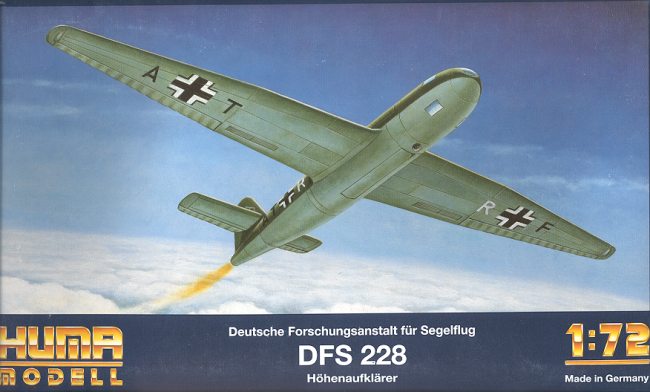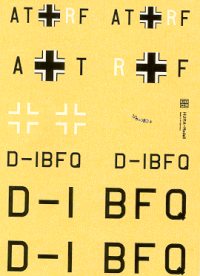
|
KIT: |
Huma 1/72 DFS-228 |
|
KIT # |
3503 |
|
PRICE: |
$17.98 |
|
DECALS: |
Two Aircraft |
|
REVIEW & |
|
|
NOTES: |

|
HISTORY |
DFS was the German Gliding Research Institute and came up with a number of interesting aircraft during the war. They were also responsible for the most widely used German transport glider, the DFS 230. In mid-1940, DFS was working on the problems of supersonic flight. It was realized that the greater the altitude, the lower the air resistance and the easier it would be to break the sound barrier. This would require the use of a lightweight aircraft that had a pressurized cockpit. The Germans already had a powerplant in its rocket motors that would give the required thrust for the project.
Being methodical about these things, DFS broke its research into three stages: First the pressurized cockpit, then the performance of swept wing aircraft and finally the actual building of the craft, which would become the DFS 346. In order to test the pressurized cockpit, the DFS.228 was designed. Though subsonic, it would be able to provide the necessary test data. The aircraft would also be used to test the pilot escape system as well.
The RLM became interested in the project and proposed that the 228 be turned into a high altitude reconnaissance aircraft in addition to being a pure research bed. The plan was to tow the aircraft to 10,000 meters. There the rocket engine would be fired and carry the aircraft up to its operational altitude of 23,000 meters (75,000 feet). Then short bursts from the rocket would keep it at altitude and when the mission was over, it would glide back to base, using any remaining fuel during the landing phase.
The initial prototype was completed in 1943 and was mostly of wooden construction. The prototype was carried aloft by the Do-217K v3, and though over 40 flights were made, none used the rocket motor. A second prototype was tested (also without using the rocket) and it varied only in that the pilot was prone in this version. The same engine as in the Me-163 was to be used, but there were doubts of its ability to restart the number of times that was required for the mission. It was also unknown if the engine would operate properly at the altitudes that it would have been flying. The first prototype was captured and taken by American forces for examination. Its ultimate fate is unknown.
|
THE KIT |
When opening the box, one is confronted with a number of items that are quite typical of Huma. A greenish grey plastic with nicely engraved panel lines, no flash, and only a few ejector pin marks to contend with. Some of these are in the landing gear bay and others on some of the bulkheads and inside the fuselage. The wings, and tailplane bits are a single piece. On my kit, one of the wings was slightly warped. There is also a finely done fret of parts that is becoming a trademark of Huma models. Most of these parts are for the cockpit, and great care needs to be taken when removing them from the sprues.
There are optional front ends for the initial prototype and you can display the aircraft with the landing skid deployed. The only interior is for a prone pilot. If the reference is correct, then this means that you cannot model the prototype with what is in the kit .
 The instructions are typical of current Huma kits with a nice
color drawing for the camo and decal placement and very nice line drawings for
the construction sequence. Unfortunately, my instructions had the interior page
double printed with about a 1/2 inch offset making it very difficult to read. No
color information is given for any of the interior parts, though I would imagine
that most of it would be RLM 66. Decals are for two aircraft. On is the
prototype with civil registration and painted an overall RLM 02. The other is
for either an operational glider or the second prototype, the instructions don't
say. it is in RLM 71 upper and RLM 65 lowers. The decal sheet, which is
semi-matte and with a goodly amount of carrier material around each decal, also
provides an instrument panel, but not a hint of a swastika. You'll have to get
that from some other source.
The instructions are typical of current Huma kits with a nice
color drawing for the camo and decal placement and very nice line drawings for
the construction sequence. Unfortunately, my instructions had the interior page
double printed with about a 1/2 inch offset making it very difficult to read. No
color information is given for any of the interior parts, though I would imagine
that most of it would be RLM 66. Decals are for two aircraft. On is the
prototype with civil registration and painted an overall RLM 02. The other is
for either an operational glider or the second prototype, the instructions don't
say. it is in RLM 71 upper and RLM 65 lowers. The decal sheet, which is
semi-matte and with a goodly amount of carrier material around each decal, also
provides an instrument panel, but not a hint of a swastika. You'll have to get
that from some other source.
|
CONSTRUCTION |
|
PAINT & DECALS |
|
CONSTRUCTION CONTINUES |
|
CONCLUSIONS |
|
REFERENCES |
German Aircraft of the Second World War, by JR Smith & Anthony Kay, Putnam, 1972.
Review kit courtesy of me and my wallet!
If you would like your product reviewed fairly and quickly by a site that has over 1,700 visits a day, please contact me or see other details in the Note to Contributors.